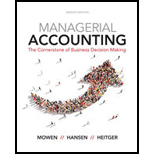
Use the following information for Brief Exercises 11-17and 11-18:
Indy Company has the following data for one of its manufacturing plants:
Maximum units produced in a quarter (3-month period): 250,000 units Actual units produced in a quarter (3-month period): 200,000 units Productive hours in one quarter: 25,000 hours
11-18 (Appendix 11A) Calculating Manufacturing Cycle Efficiency
Refer to the information of Indy Company above. The actual cycle time for Indy Company is 7.5 minutes, and the theoretical cycle time is 6 minutes.
Required:
1. Calculate the amount of processing time and the amount of nonprocessing time.
2. Calculate the MCE. (Round to one decimal place.)
Want to see the full answer?
Check out a sample textbook solution
Chapter 11 Solutions
Bundle: Managerial Accounting: The Cornerstone of Business Decision-Making, Loose-Leaf Version, 7th + CengageNOWv2, 1 term (6 months) Printed Access Card
- What was the balance in interest payable on the 2021 balance sheet for this financial accounting question?arrow_forwardWhat amount of interest has accrued as of August 31, 2022 on these financial accounting question?arrow_forwardPlease give me true answer this financial accounting questionarrow_forward
 Managerial Accounting: The Cornerstone of Busines...AccountingISBN:9781337115773Author:Maryanne M. Mowen, Don R. Hansen, Dan L. HeitgerPublisher:Cengage Learning
Managerial Accounting: The Cornerstone of Busines...AccountingISBN:9781337115773Author:Maryanne M. Mowen, Don R. Hansen, Dan L. HeitgerPublisher:Cengage Learning Managerial AccountingAccountingISBN:9781337912020Author:Carl Warren, Ph.d. Cma William B. TaylerPublisher:South-Western College Pub
Managerial AccountingAccountingISBN:9781337912020Author:Carl Warren, Ph.d. Cma William B. TaylerPublisher:South-Western College Pub Financial And Managerial AccountingAccountingISBN:9781337902663Author:WARREN, Carl S.Publisher:Cengage Learning,
Financial And Managerial AccountingAccountingISBN:9781337902663Author:WARREN, Carl S.Publisher:Cengage Learning, Principles of Cost AccountingAccountingISBN:9781305087408Author:Edward J. Vanderbeck, Maria R. MitchellPublisher:Cengage Learning
Principles of Cost AccountingAccountingISBN:9781305087408Author:Edward J. Vanderbeck, Maria R. MitchellPublisher:Cengage Learning Cornerstones of Cost Management (Cornerstones Ser...AccountingISBN:9781305970663Author:Don R. Hansen, Maryanne M. MowenPublisher:Cengage LearningPrinciples of Accounting Volume 2AccountingISBN:9781947172609Author:OpenStaxPublisher:OpenStax College
Cornerstones of Cost Management (Cornerstones Ser...AccountingISBN:9781305970663Author:Don R. Hansen, Maryanne M. MowenPublisher:Cengage LearningPrinciples of Accounting Volume 2AccountingISBN:9781947172609Author:OpenStaxPublisher:OpenStax College





